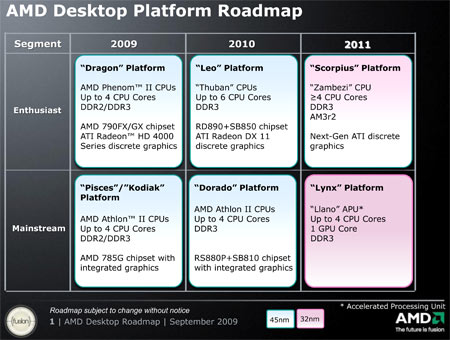AMD Phenom II X4 965 BE: Same Speed, Less Power
Introduction
It's no secret that AMD has its work cut out for it right now. The company's top-of-the-line flagship Phenom II X4 965 isn't in the same league as Intel's premium Core i7. Even Intel's mid-range Core i5-750 CPU is a powerful adversary for the similarly-priced Phenom II X4 965, and while it puts up a decent fight, AMD's champion is bested far more often than not.
AMD will answer the high-performance challenge with the "Thuban" six-core CPU in 2010, a processor based on the already-released hexa-core Opteron. The consumer version of this processor is likely to be called the Phenom II X6, we have to guess.
While Thuban will compete more readily against Intel's Core i7, there are two looming problems with this plan. First, it probably won't happen until close to the middle of 2010 (a virtual eternity in the tech sector), and by that time Intel will likely be ready to launch the six-core "Gulftown" processor (purportedly Core i9). In 2011, we can see some game-changers in AMD's plans, such as a new high-end platform and the fruition of the "Fusion" processor featuring a graphics processor on-die. But at least until then, it looks like AMD will have an uphill battle in the high-end consumer space.
Faced with these facts, AMD is cleverly playing up the longevity strategy that served it so well in the Socket A days. In other words, keep the new CPUs backward-compatible with established sockets. On the other hand, platform longevity is something Intel has never expressed much of an interest in extending. While Intel jumped sockets from the Pentium III to Pentium 4, AMD stayed with Socket A all the way from the original 600 MHz Duron to the newest Athlon XP 3200+. Fast forward to today, and Intel offers the LGA 775 Core 2 Duo, LGA 1156 Core i5, and LGA 1366 Core i7 processors; all current models with different socket interfaces.
Contrast that with AMD's new AM3 Athlon II and Phenom II processors, all of which will work on older AM2+/DDR2 motherboards as well as new AM3/DDR3 platforms. The significance of this is compelling when you realize the upgrade path that exists for AMD's customers. Someone who purchased an AM2+/Athlon 64 X4 combo last year can upgrade not only to a faster Athlon II X2/X3/X4 processor, but also a formidable Phenom II X2/X3/X4. There is even a good possibility that their current motherboard might work with the upcoming Phenom II X6 when those CPUs arrive next year (assuming a similar maximum TDP). All of these upgrades are possible without changing a single component, except the processor.
All of this plays into AMD's strength in the entry-level space, with very compelling low-cost platforms and CPUs in a segment that Intel hasn't yet really fought to control. Right now, a budget buyer can get an Athlon II X3 435 for under $90 and a decent motherboard for under $100. When the time comes for an upgrade, is that user going to start over and build a Core i5 system from the ground-up, or are they more likely to buy a Phenom II X4 processor and realize similar performance without having to change platforms? When we look at things from this perspective, we see AMD can offer huge upgrade advantages over Intel products, despite the performance disparity with the new Core i5 and i7 processors.
While AMD's flagship Phenom II X4 965 has recently come down in price to $195 ($5 less than Intel's new Core i5-750), it isn't an ideal upgrader's CPU for many AM2+/AM3 motherboards because of its 140 watt maximum TDP, as many motherboards limit their support to 125 watt CPUs. It is because of this that some upgraders may be interested in the new revision of Phenom II X4 965 Black Edition sporting a maximum 125 watt TDP, among other refinements.
Get Tom's Hardware's best news and in-depth reviews, straight to your inbox.
Current page: Introduction
Next Page A Little Bit Better: The Revised Phenom II X4 965 BE CPUDon Woligroski was a former senior hardware editor for Tom's Hardware. He has covered a wide range of PC hardware topics, including CPUs, GPUs, system building, and emerging technologies.
